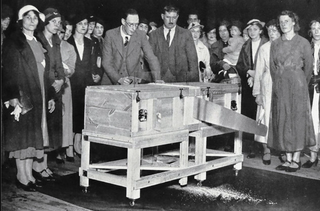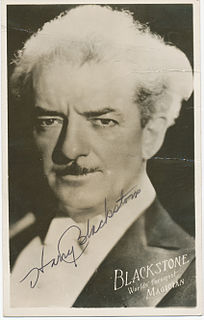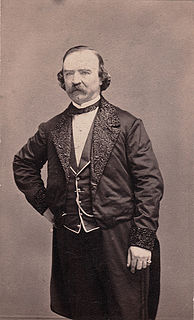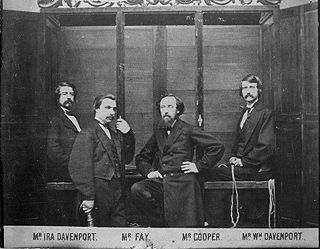Related Research Articles

The Balducci levitation is a levitation illusion first described by Ed Balducci. Its inventor is unknown. It is an impromptu magic trick, which has been popularized by many magicians, such as David Roth, Paul Harris, and David Blaine.

In theatrical magic, misdirection is a form of deception in which the performer draws audience attention to one thing to distract it from another. Managing audience attention is the aim of all theater, and the foremost requirement of all magic acts. Whether the magic is of a "pocket trick" variety or a large stage production, misdirection is the central secret. The term describes either the effect or the sleight of hand or patter that creates it.

Coin magic is the manipulating of coins to entertain audiences. Because coins are small, most coin tricks are considered close-up magic or table magic, as the audience must be close to the performer to see the effects. Though stage conjurers generally do not use coin effects, coin magic is sometimes performed onstage using large coins. In a different type of performance setting, a close-up coin magician will use a large video projector so the audience can see the magic on a big screen. Coin magic is generally considered harder to master than other close-up techniques such as card magic, as it requires great skill and grace to perform convincingly, and this requires much practice to acquire.

P. T. Selbit (1881–1938) was an English magician, inventor and writer who is credited with being the first person to perform the illusion of sawing a woman in half. Among magicians he was known for his inventiveness and entrepreneurial instinct and he is credited with creating a long list of successful stage illusions.

Mentalism is a performing art in which its practitioners, known as mentalists, appear to demonstrate highly developed mental or intuitive abilities. Performances may appear to include hypnosis, telepathy, clairvoyance, divination, precognition, psychokinesis, mediumship, mind control, memory feats, deduction, and rapid mathematics. Mentalists perform a theatrical act that includes effects that may appear to employ psychic or supernatural forces but that are actually achieved by "ordinary conjuring means", natural human abilities, and an in-depth understanding of key principles from human psychology or other behavioral sciences.

Sawing a woman in half is a generic name for a number of stage magic tricks in which a person is apparently cut or divided into two or more pieces.

Harry Bouton Blackstone was a famed stage magician and illusionist of the 20th century. Blackstone was born Harry Bouton in Chicago, Illinois. He began his career as a magician in his teens and was popular through World War II as a USO entertainer. He was often billed as The Great Blackstone. His son Harry Blackstone Jr. also became a famous magician. Blackstone Sr. was aided by his younger brother, Pete Bouton, who was the stage manager in all his shows. Blackstone Sr. was married three times. Blackstone Jr. was his son by his second wife.
The bullet catch is a stage magic illusion in which a magician appears to catch a bullet fired directly at them — often in the mouth, sometimes in the hand or sometimes caught with other items such as a dinner plate. The bullet catch may also be referred to as the bullet trick, defying the bullets or occasionally the gun trick.

Street magic falls into two genres; traditional street performance and guerrilla magic.

John Henry Anderson (1814–1874) was a Scottish professional magician. Anderson is credited with helping bring the art of magic from street performances into theatres and presenting magic performances to entertain and delight the audience.

Ira Erastus Davenport and William Henry Davenport, known as the Davenport brothers, were American magicians in the late 19th century, sons of a Buffalo, New York policeman. The brothers presented illusions that they and others claimed to be supernatural.
The Zig-Zag Girl illusion is a stage illusion akin to the more famous sawing a woman in half illusion. In the Zig-Zag illusion, a magician divides an assistant into thirds, only to have them emerge from the illusion at the end of the performance completely unharmed.
Isaiah Harris Hughes, better known as the Fakir of Ava, was a 19th-century stage magician, the teacher of Harry Kellar.
A magician's assistant is a performer in a magic act who is not billed as the magician or principal name in the act. The role of an assistant can include holding the props that are used by a magician, shifting props onto and off the stage, and serving as a living prop in illusions that involve manipulation of the human body. Other aspects of the role can include dancing or acting as visual ornamentation, sometimes for simple aesthetic purposes and sometimes to misdirect audience attention. The figure of the glamorous female assistant has become a stereotype or icon in art, popular media and fiction.

Mark Wilson's Complete Course in Magic is a book on magic written by magician Mark Wilson. The book is a popular reference for magicians and has been in print since its first issue in 1975.
Impaled is a classic stage illusion in which a performer appears to be impaled on or by a sword or pole. The name is most commonly associated with an illusion that was created by designer Ken Whitaker in the 1970s and which is sometimes also referred to as "Beyond Belief" or "Impaled Beyond Belief". This version has become part of the stage magic repertoire and has been performed by many of the world's most famous magic acts.
The needle through thumb is the name of a magic trick which is meant to give the illusion that the magician is actually stabbing his own thumb using several sewing needles.

Magic, which encompasses the subgenres of illusion, stage magic, and close up magic, among others, is a performing art in which audiences are entertained by tricks, effects, or illusions of seemingly impossible feats, using natural means. It is to be distinguished from paranormal magic which are effects claimed to be created through supernatural means. It is one of the oldest performing arts in the world.

A levitation illusion is one in which a magician appears to defy gravity by making an object or person float in the air. The subject may appear to levitate unassisted, or it may be performed with the aid of another object in which case it is termed a "suspension".
References
- ↑ Mead, Eric. "The magic of the placebo". TED. Retrieved 10 April 2015.
- 1 2 Caveney, Mike (1993). Harry Anderson: Wise Guy from the Street to the Screen (2nd ed.). Pasadena, Calif.: Magical Publications. ISBN 0915181258.
- ↑ Hawkes, Rebecca (16 November 2016). "David Blaine: the gory secrets behind some of his most mind-boggling illusions". The Telegraph. Retrieved 24 September 2018.
- ↑ Rodriguez, Dan (May 2014). "Magic Moments: The Bruce and Kitty Spangler Story" (PDF). M-U-M Magazine. Society of American Magicians. p. 36. Retrieved 11 May 2015.
- 1 2 "SNL Transcripts: Ron Howard: 10/09/82: Harry Anderson". jt.org.
